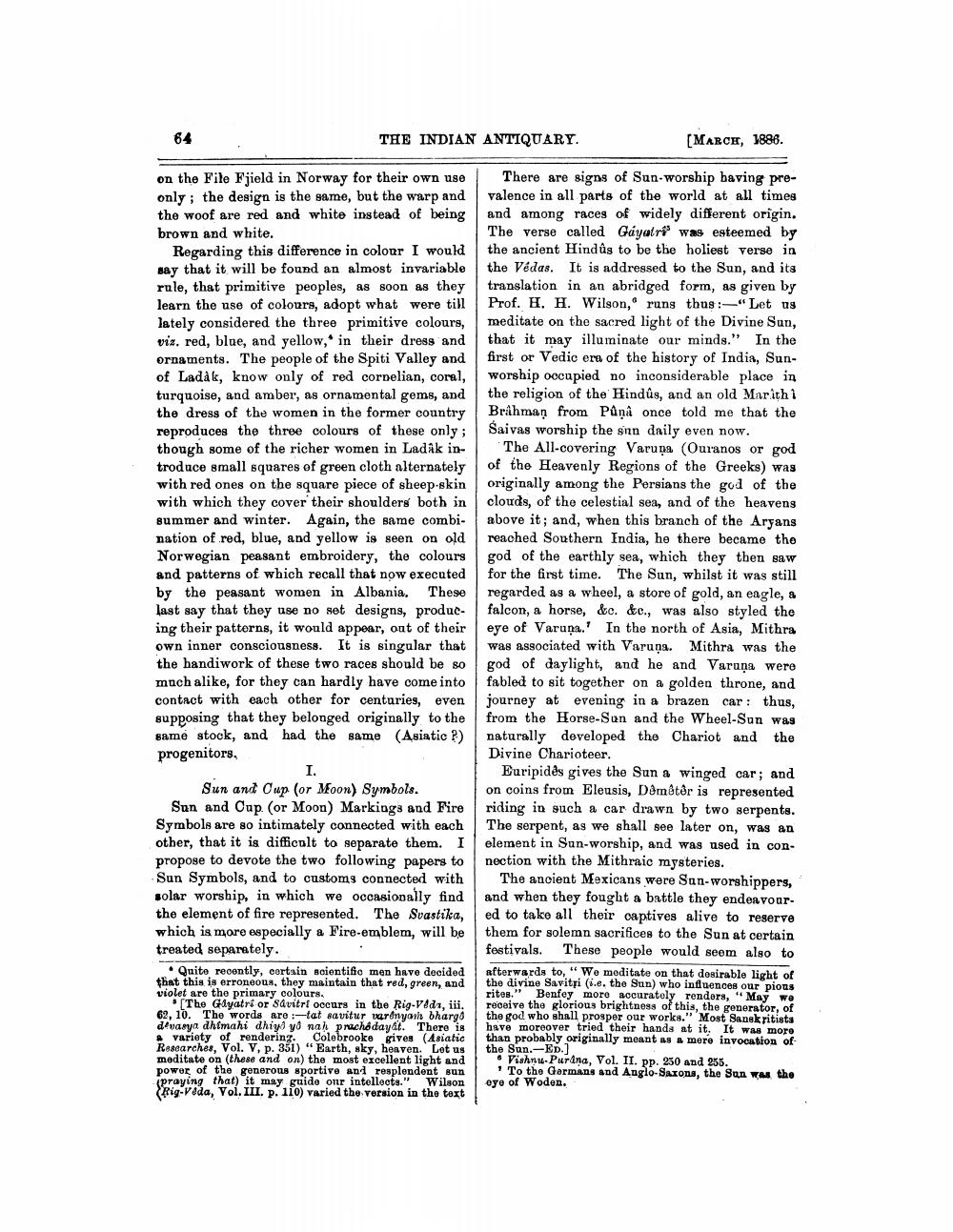________________
64
THE INDIAN ANTIQUARY.
[MARCH, 1886.
on the File Fjield in Norway for their own use There are signs of Sun-worship baving preonly; the design is the same, but the warp and valence in all parts of the world at all times the woof are red and white instead of being and among races of widely different origin. brown and white.
The verse called Gayatri' was esteemed by Regarding this difference in colour I would the ancient Hindûs to be the holiest verse in say that it will be found an almost invariable the Vedas. It is addressed to the Sun, and its rule, that primitive peoples, as soon as they translation in an abridged form, as given by learn the use of colours, adopt what were till Prof. H. H. Wilson, rung thus:-"Let us lately considered the three primitive colours, meditate on the sacred light of the Divine Sun, viz, red, blue, and yellow, in their dress and that it may illuminate our minds." In the ornaments. The people of the Spiti Valley and first or Vedic era of the history of India, Sunof Ladåk, know only of red cornelian, coral, worship occupied no inconsiderable place in turquoise, and amber, as ornamental gems, and the religion of the Hindûs, and an old Marithi the dress of the women in the former country Brahman from Puņà once told me that the reproduces the three colours of these only; Saivas worship the sin daily even now. though some of the richer women in Ladak in- The All-covering Varuna (Ouranos or god troduce small squares of green cloth alternately of the Heavenly Regions of the Greeks) was with red ones on the square piece of sheep-skin originally among the Persians the god of the with which they cover their shoulders both in clouds, of the celestial sea, and of the heavens summer and winter. Again, the same combi- above it; and, when this branch of the Aryans nation of red, blue, and yellow is seen on old reached Southern India, he there became the Norwegian peasant embroidery, the colours god of the earthly sea, which they then saw and patterns of which recall that now executed for the first time. The Sun, whilst it was still by the peasant women in Albania. These regarded as a wheel, a store of gold, an eagle, a last say that they use no set designs, produc- falcon, a horse, &c. &c., was also styled the ing their patterns, it would appear, out of their eye of Varuņa.' In the north of Asia, Mithra own inner consciousness. It is singular that was associated with Varuņa. Mithra was the the handiwork of these two races should be so god of daylight, and he and Varuņa were much alike, for they can hardly have come into fabled to sit together on a golden throne, and contact with each other for centuries, even journey at evening in a brazen car: thus, supposing that they belonged originally to the from the Horse-Sun and the Wheel-Sun was same stock, and had the same (Asiatic?) naturally developed the Chariot and the progenitors.
Divine Charioteer.
Euripides gives the Sun a winged car; and Sun and Cup (or Moon) Symbols. on coins from Eleusis, Domoter is represented Sun and Cup. (or Moon) Markings and Fire riding in such a car drawn by two serpents. Symbols are so intimately connected with each The serpent, as we shall see later on, was an other, that it is difficult to separate them. I element in Sun-worship, and was used in conpropose to devote the two following papers to nection with the Mithraic mysteries. Sun Symbols, and to customs connected with the ancient Mexicans were San-worshippers, solar worship, in which we occasionally find and when they fought a battle they endeavour. the element of fire represented. The Svastika, ed to take all their captives alive to reserve which is more especially a Fire-emblem, will be them for solemn sacrifices to the Sun at certain treated separately.
festivals. These people would seem also to • Quite reoontly, cortain scientifio men have decided afterwards to, "We moditate on that desirable light of that this is erroneous, they maintain that red, green, and
the divine Saviti i.e. the Sun) who influences our pious violet are the primary colours.
rites." Benfey more accurately renders, "May we [The Gayatri or savitri occurs in the Rig-védi, iii. receive the glorious brightness of this, the generator, of 62. 10. The words are:-tat savitur warányosh bharg8the god who shall prosper our works." Most Sanskritista divasya dhimahi dhiyi yo nan prachadayal. There is have moreover tried their hands at it. It was moro # variety of rendering, Colebrooke gives (Asiatic than probably originally meant as a mere invocation of Researches, Vol. V, p. 351). "Earth, sky, honven. Let us the Sun.- ED.) meditate on these and on) the most excellent light and Vishnu Purina, Vol. II. pp. 250 and 255. power of the generous sportive and resplendent eun To the Germans and Anglo-Saxons, the San was the praying that) it may guide onr intellects." Wilson oye of Woden. (Rig Veda, Vol. III. p. 110) varied the version in the text
1.
eye of Woden mans and Ang
Version in the Laon




